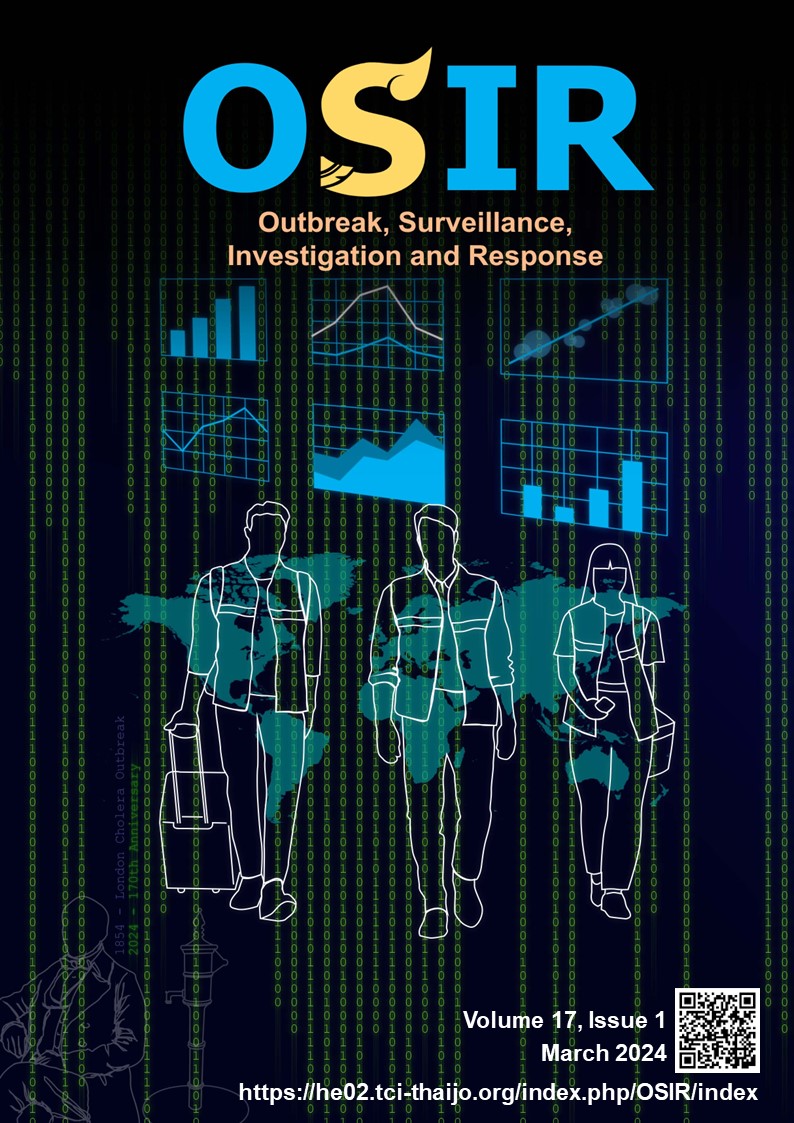Implementation of Strategies to Prevent Mother-to-child Transmission of Hepatitis B Virus Infection, Thailand, 2016–2017
DOI:
https://doi.org/10.59096/osir.v17i1.265434Keywords:
hepatitis B virus, hepatitis B infection, mother-to-child transmission, ThailandAbstract
Mother-to-child transmission (MTCT) of hepatitis B virus can cause chronic liver disease. Thailand aimed to eliminate MTCT of hepatitis B virus by 2025. Strategies include hepatitis B surface antigen (HBsAg) screening for pregnant women, antiviral therapy for infected mother, hepatitis B birth dose vaccination (HepB-BD), HBV immunoglobulin (HBIG) administration and post-vaccination serologic testing (PVST) for infants born to HBsAg-positive mother. The objectives of this study were to assess the management of HBsAg-positive mothers and their infants. We reviewed medical records of HBsAg-positive pregnant women and their infants born during 1 Jan 2016–31 Dec 2017 at 14 hospitals in seven provinces to assess the percentage of women who were tested and treated for HBV and the percentage of infants born to them who received HepB-BD, HBIG and underwent PVST. All 69,303 pregnant women were screened for HBsAg and 1,179 (1.7%) were HBsAg positive. Of 1,179 HBsAg-positive women, 219 (18.6%) were tested for hepatitis B e-antigen (HBeAg) and 85 (38.8%) were HBeAg positive; 29 (2.5%) were tested for HBV DNA and 14 (48.3%) had viral load ≥200,000 IU/mL. Of 90 women eligible for antiviral therapy, 16 (17.8%) received treatment. Among 1,144 infants with available records, HepB-BD and HBIG coverage was 99.3% and 45.8%. Of 966 children with follow-up records, 12.2% underwent PVST and all were HBsAg negative. In conclusion, while the coverage of maternal HBsAg screening and infant HepB-BD was high, few women received follow-up testing and treatment. HBIG administration for infants was low and PVST rate still needed improvement.
References
World Health Organization. Hepatitis B [Internet]. Geneva: World Health Organization; 2020 [cited 2021 May 28]. <https://www.who.int/news-room/fact-sheets/detail/hepatitis-b>
World Health Organization. Global hepatitis report, 2017 [Internet]. Geneva: World Health Organization; 2017 [cited 2021 May 28]. 68 p. <https://apps.who.int/iris/bitstream/handle/10665/255016/9789241565455-eng.pdf?sequence=1>
World Health Organization. Global progress report on HIV, viral hepatitis and sexually transmitted infections, 2021 [Internet]. Geneva: World Health Organization; 2021 Jul 15 [cited 2021 Jul 29]. 108 p. <https://www.who.int/publications/i/item/9789240027077>
Division of Viral Hepatitis, National Center for HIV, Viral Hepatitis, STD, and TB Prevention. Hepatitis B – FAQs, statistics, data, & guidelines [Internet]. Atlanta: Centers for Disease Control and Prevention (US); 2020 [cited 2021 May 28]. <https://www.cdc.gov/hepatitis/hbv/index.htm>
World Health Organization Western Pacific Region. Preventing mother-to-child transmission of hepatitis B operational field guidelines for delivery of the birth dose of hepatitis B vaccine. Manila: World Health Organization; 2006. 42 p.
Giovanna F, Bortolotti F, Francesco D. Natural history of chronic hepatitis B: Special emphasis on disease progression and prognostic factors. J Hepatol. 2008 Feb;48(2):335–52. doi:10.1016/j.jhep.2007.11.011.
Wen WH, Chang MH, Zhao LL, Ni YH, Hsu HY, Wu JF, et al. Mother-to-infant transmission of hepatitis B virus infection: significance of maternal viral load and strategies for intervention. J Hepatol [Internet]. 2013 [cited 2021 May 28];59(1):24–30. <https://doi.org/10.1016/j.jhep.2013.02.015>
World Health Organization. Prevention of mother-to-child transmission of hepatitis B virus: guideline on antiviral prophylaxis in Pregnancy. Genava: World Health Organization; 2020. 58 p.
Jourdain G, Ngo-Giang-Huong N, Harrison L, Decker L, Khamduang W, Tierney C, et al. Tenofovir versus placebo to prevent perinatal transmission of hepatitis B. N Engl J Med. 2018;378(10):911–23. doi:10.1056/NEJMoa1708131.
Shao ZJ, Zhang L, Xu JQ, Xu DZ, Men K, Zhang JX, et al. Mother-to-infant transmission of hepatitis B virus: a chinese experience. J Med Virol. 2011;83(5):791–5. doi:10.1002/jmv.22043.
Younossi ZM, Wong G, Anstee QM, Henry L. The global burden of liver disease. Clin Gastroenterol Hepatol. 2023 Jul;21(8):1978–91. doi:10.1016/j.cgh.2023.04.015.
Posuwan N, Wanlapakorn N, Sa-Nguanmoo P, Wasitthankasem R, Vichaiwattana P, Klinfueng S, et al. The success of a universal hepatitis B immunization program as part of Thailand’s EPI after 22 years’ implementation. PLoS One. 2016;11(3):e0150499. doi:10.1371/journal.pone.0150499.
World Health Organization. WHO vaccine-preventable diseases: monitoring system. 2020 global summary [Internet]. Geneva: World Health Organization; 2020 [cited 2024 Mar 19]. <https://immunizationdata.who.int/pages/coverage/hepb.html?CODE=THA&ANTIGEN=&YEAR=>
Subcommittee of prevention and control of hepatitis due to virus infection and Elimination of hepatits B virus from mother to child transmission team. Practice guideline for elimination of hepatitis B virus from mother to child transmission. Nonthaburi: Coordinating center of Hepatitis due to virus infection, Division of Vaccine Preventable Diseases, Department of Disease Control, Ministry of Public Health (TH); 2018. 5 p.
World Health Organization. Global health sector strategy on viral hepatitis 2016–2021: towards ending viral hepatitis. Geneva: World Health Organization; 2016 Jun [cited 2021 May 28]. 53 p. <http://apps.who.int/iris/bitstream/handle/10665/246177/WHO-HIV-2016.06-eng.pdf?sequence=1>
World Health Organization. Global policy report on the prevention and control of viral hepatitis in WHO member states [Internet]. Geneva: World Health Organizaiton; 2013 Jul 22 [cited 2021 May 28]. 150 p. <https://www.who.int/publications/i/item/global-policy-report-on-the-prevention-and-control-of-viral-hepatitis-in-who-member-states>
Chen Y, Xie C, Zhang Y, Li Y, Ehrhardt S, Thio CL, et al. Knowledge regarding hepatitis B mother-to-child transmission among healthcare workers in South China. J Viral Hepat [Internet]. 2018 May [cited 2020 Feb 28];25(5): 561–70. <https://doi.org/10.1111/jvh.12839>
World Health Organization South-East Asia Regional Office. Bangladesh, Bhutan, Nepal and Thailand achieve hepatitis B control: WHO [Internet]. New Delhi: World Health Organization; 2019 Jul 26 [cited 2020 Apr 7]. <https://www.who.int/southeastasia/news/detail/26-07-2019-bangladesh-bhutan-nepal-and-thailand-achieve-hepatitis-b-control-who>
Downloads
Published
How to Cite
Issue
Section
License
Copyright (c) 2024 Outbreak, Surveillance, Investigation & Response (OSIR) Journal

This work is licensed under a Creative Commons Attribution-NonCommercial-NoDerivatives 4.0 International License.









